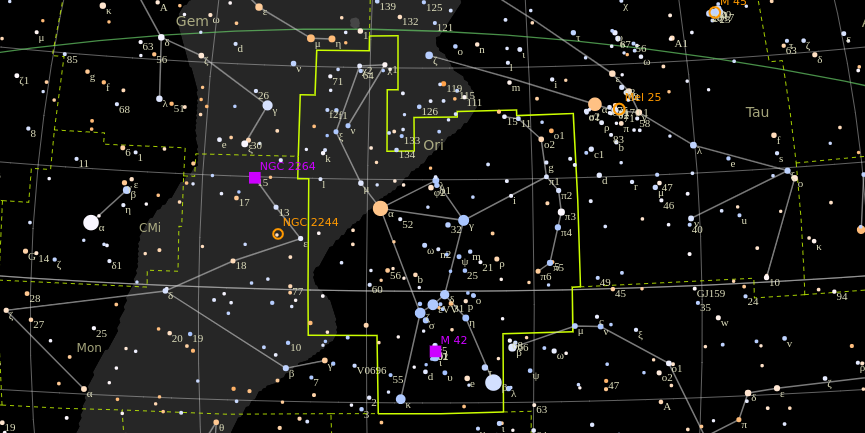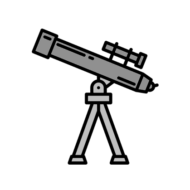What Are Constellations?
The word Constellation comes from Latin and means “set of stars”, so simply put, a Constellation is just a recognizable pattern of stars in the night sky. It’s also important to understand that the constellation does not just include the bright stars with the imaginary lines forming various shapes. A constellation also has set boundaries and all the astronomical objects in that region are considered to be part of that constellation.
For example, in the following image of the constellation Orion, the lines that represent the shape of the constellation are gray and the boundary of the constellation is green. All the stars and other objects within that boundary are part of the constellation.

There are 88 constellations in the sky giving complete coverage to every point on the celestial globe. So every star and object in the sky falls within the boundaries of one of the 88 constellations.
Where Did Constellations Come From?
Of the 88 constellations, 50 of them are ancient, with names that are Latin in origin, and date from the Roman Empire. However many of the constellations names originated from the distant past, from ancient Egypt or Babylon, as far back as before 3000 B.C. The other 38 constellations are considered to be modern and were identified later by astronomers between the 15th and 17th centuries. Some examples of these are Pavo the Peacock, or Telescopium the Telescope.
By the early 19th century there was a lot of confusion over constellations and their boundaries. Many cultures having their own set of constellations and names, and at the time many schools of astronomy had prepared their own star maps using their own boundaries. To help resolve this confusion in 1930 the International Astronomical Union published star maps with names and boundaries officially assigned to 88 constellations providing coverage to the entire sky. These constellation boundaries are used today by modern astronomers.
Constellations of the Zodiac
The Sun, Moon and Planets follow a consistent path through the sky and throughout the constellations, this path is known as the ecliptic. The constellations that follow the line of the ecliptic are known as the constellations of the Zodiac. According to astrology there are 12 zodiac constellation but astronomically speaking there are actually 13 constellations: Capricornus, Aquarius, Pisces, Aries, Taurus, Gemini, Cancer, Leo, Virgo, Libra, Scorpius, Sagittarius, and Ophiuchus, the 13th constellation being Ophiuchus which is not one of the astrological constellations.
If you are into astrology and like to check your Horoscope, then the 12 constellations of the Zodiac have special significance. However, for astronomers the 13 constellations of the Zodiac are no more important as all the other constellations.
Visibility of the Constellations
Not all the constellations are visible throughout the year, if you observe the constellations from month to month you will notice that they are continually shifting to the west. This westward shift is caused by the earths orbit around the sun. The dark side of the earth is pointing in different directions as the earth goes around the sun.
Try An Experiment
To illustrate this shift you could try a simple experiment using a lamp, to represent the sun, and a ball, to represent the earth. Place the lamp in the middle of the room, then hold the ball as you walk around the lamp. As you walk (orbit) around the lamp, notice that the dark side of the ball, the side of the ball that is not getting light from the lamp, will face each wall as you move around the lamp. This is the same way it works as Earth goes around the sun and is the reason why some constellations are only visible during certain months of the year.
Circumpolar Constellations
Some constellations are visible throughout the year, these are considered to be circumpolar because they never set below the horizon. If you are in the northern hemisphere then the major circumpolar constellations are: Cassiopeia, Cepheus, Draco, Ursa Major, and Ursa Minor. If you are in the southern hemisphere then the major circumpolar constellations are: Carina, Centaurus, and Crux.
Why Are Constellations Important?
For modern professional and amateur astronomers having knowledge of where things are in the night sky is essential. Knowing where the constellations are helps us to orient ourselves and recognize specific stars and patterns in the night sky. When looking at objects in the night sky the constellation is part of the objects address. For example, when there is a new comet in town I want to know where it is, if know what constellation its in then I know where to start looking for it.
If you are just getting started with astronomy don’t run out and buy you a new smart telescope (at least now yet). First get some star charts and start identifying the constellations and learning the names of some of the brighter stars in those constellations.
List Of Constellations
| Name (Latin) | Abbreviation | Genitive | Description |
|---|---|---|---|
| Andromeda | And | Andromedae | Chained Maiden / Princess of Ethiopia |
| Antlia | Ant | Antliae | Air pump |
| Apus | Aps | Apodis | Bird of Paradise |
| Aquila | Aql | Aquilae | Eagle |
| Aquarius | Aqr | Aquarii | Water Bearer |
| Ara | Ara | Arae | Altar |
| Aries | Ari | Arietis | Ram |
| Auriga | Aur | Aurigae | Charioteer |
| Boötes | Boo | Boötis | Herdsman |
| Canis Major | CMa | Canis Majoris | Great Dog |
| Canis Minor | CMi | Canis Minoris | Canis Minoris |
| Canes Venatici | CVn | Canum Venaticorum | Hunting Dogs |
| Caelum | Cae | Caeli | Engraving Tool |
| Camelopardalis | Cam | Camelopardalis | Giraffe |
| Capricornus | Cap | Capricorni | Sea Goat |
| Carina | Car | Carinae | Keel |
| Cassiopeia | Cas | Cassiopeiae | Seated Queen |
| Centaurus | Cen | Centauri | Centaur |
| Cepheus | Cep | Cephei | King |
| Cetus | Cet | Ceti | Sea Monster |
| Chamaeleon | Cha | Chamaeleontis | Chameleon |
| Circinus | Cir | Circini | Drafting Compass |
| Cancer | Cnc | Cancri | Cancri |
| Columba | Col | Columbae | Columbae |
| Coma Berenices | Com | Comae Berenices | Berenice’s Hair |
| Corona Austrina | CrA | Coronae Australis | Southern Crown |
| Corona Borealis | CrB | Coronae Borealis | Northern Crown |
| Crater | Crt | Crateris | Crateris |
| Crux | Cru | Crucis | Southern Cross |
| Corvus | Crv | Corvi | Corvi |
| Cygnus | Cyg | Cygni | Swan |
| Delphinus | Del | Delphini | Dolphin |
| Dorado | Dor | Doradus | Dolphinfish |
| Draco | Dra | Draconis | Draconis |
| Equuleus | Equ | Equulei | Little Horse |
| Eridanus | Eri | Eridani | River |
| Fornax | For | Fornacis | Furnace |
| Gemini | Gem | Geminorum | Twins |
| Grus | Gru | Gruis | Crane |
| Hercules | Her | Herculis | Hercules |
| Horologium | Hor | Horologii | Clock |
| Hydra | Hya | Hydrae | Water Snake |
| Hydrus | Hyi | Hydri | Male Water Snake |
| Indus | Ind | Indi | Indian |
| Leo Minor | LMi | Leonis Minoris | Lesser Lion |
| Lacerta | Lac | Lacertae | Lizard |
| Leo | Leo | Leonis | Lion |
| Lepus | Lep | Leporis | Hare |
| Libra | Lib | Librae | Scales |
| Lupus | Lup | Lupi | Wolf |
| Lynx | Lyn | Lyncis | Lynx |
| Lyra | Lyr | Lyrae | Lyre or harp |
| Mensa | Men | Mensae | Table |
| Microscopium | Mic | Microscopii | Microscope |
| Monoceros | Mon | Monocerotis | Unicorn |
| Musca | Mus | Muscae | Fly |
| Norma | Nor | Normae | Carpenter’s Square |
| Octans | Oct | Octantis | Octant |
| Ophiuchus | Oph | Ophiuchi | Serpent Bearer |
| Orion | Ori | Orionis | Hunter |
| Pavo | Pav | Pavonis | Peacock |
| Pegasus | Peg | Pegasi | Winged Horse |
| Perseus | Per | Persei | Hero |
| Phoenix | Phe | Phoenicis | Phoenix |
| Pictor | Pic | Pictoris | Painter |
| Piscis Austrinus | PsA | Piscis Austrini | Southern Fish |
| Pisces | Psc | Piscium | Fishes |
| Puppis | Pup | Puppis | Stern |
| Pyxis | Pyx | Pyxidis | Magnetic Compass |
| Reticulum | Ret | Reticulii | Reticle |
| Sculptor | Scl | Sculptoris | Sculptor |
| Scorpius | Sco | Scorpii | Scorpion |
| Scutum | Sct | Scuti | Shield |
| Serpens | Ser | Serpentis | Serpent |
| Sextans | Sex | Sextantis | Sextant |
| Sagitta | Sge | Sagittae | Arrow |
| Sagittarius | Sgr | Sagittarii | Archer |
| Taurus | Tau | Tauri | Bull |
| Telescopium | Tel | Telescopii | Telescope |
| Triangulum Australe | TrA | Trianguli Australis | Southern Triangle |
| Triangulum | Tri | Trianguli | Triangle |
| Tucana | Tuc | Tucanae | Toucan |
| Ursa Major | UMa | Ursae Majoris | Great Bear |
| Ursa Minor | UMi | Ursae Minoris | Lesser Bear |
| Vela | Vel | Velorum | Sails |
| Virgo | Vir | Virginis | Maiden |
| Volans | Vol | Volantis | Flying Fish |
| Vulpecula | Vul | Vulpeculae | Fox |
